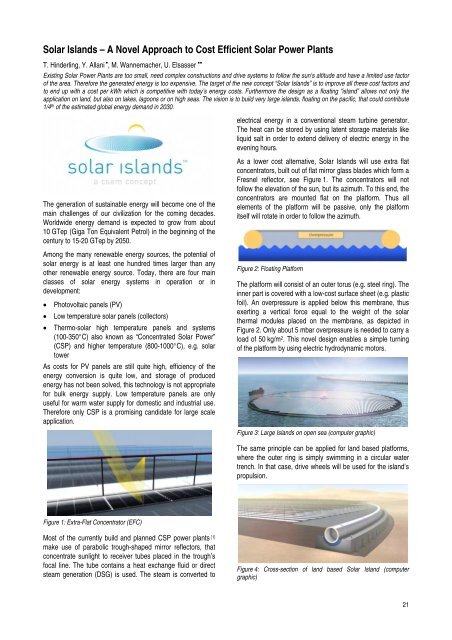research activities in 2007 - CSEM
research activities in 2007 - CSEM
research activities in 2007 - CSEM
You also want an ePaper? Increase the reach of your titles
YUMPU automatically turns print PDFs into web optimized ePapers that Google loves.
Solar Islands – A Novel Approach to Cost Efficient Solar Power Plants<br />
T. H<strong>in</strong>derl<strong>in</strong>g, Y. Allani • , M. Wannemacher, U. Elsasser ••<br />
Exist<strong>in</strong>g Solar Power Plants are too small, need complex constructions and drive systems to follow the sun’s altitude and have a limited use factor<br />
of the area. Therefore the generated energy is too expensive. The target of the new concept “Solar Islands” is to improve all these cost factors and<br />
to end up with a cost per kWh which is competitive with today’s energy costs. Furthermore the design as a float<strong>in</strong>g “island” allows not only the<br />
application on land, but also on lakes, lagoons or on high seas. The vision is to build very large islands, float<strong>in</strong>g on the pacific, that could contribute<br />
1/4 th of the estimated global energy demand <strong>in</strong> 2030.<br />
The generation of susta<strong>in</strong>able energy will become one of the<br />
ma<strong>in</strong> challenges of our civilization for the com<strong>in</strong>g decades.<br />
Worldwide energy demand is expected to grow from about<br />
10 GTep (Giga Ton Equivalent Petrol) <strong>in</strong> the beg<strong>in</strong>n<strong>in</strong>g of the<br />
century to 15-20 GTep by 2050.<br />
Among the many renewable energy sources, the potential of<br />
solar energy is at least one hundred times larger than any<br />
other renewable energy source. Today, there are four ma<strong>in</strong><br />
classes of solar energy systems <strong>in</strong> operation or <strong>in</strong><br />
development:<br />
• Photovoltaic panels (PV)<br />
• Low temperature solar panels (collectors)<br />
• Thermo-solar high temperature panels and systems<br />
(100-350°C) also known as “Concentrated Solar Power”<br />
(CSP) and higher temperature (800-1000°C), e.g. solar<br />
tower<br />
As costs for PV panels are still quite high, efficiency of the<br />
energy conversion is quite low, and storage of produced<br />
energy has not been solved, this technology is not appropriate<br />
for bulk energy supply. Low temperature panels are only<br />
useful for warm water supply for domestic and <strong>in</strong>dustrial use.<br />
Therefore only CSP is a promis<strong>in</strong>g candidate for large scale<br />
application.<br />
Figure 1: Extra-Flat Concentrator (EFC)<br />
Most of the currently build and planned CSP power plants [1]<br />
make use of parabolic trough-shaped mirror reflectors, that<br />
concentrate sunlight to receiver tubes placed <strong>in</strong> the trough’s<br />
focal l<strong>in</strong>e. The tube conta<strong>in</strong>s a heat exchange fluid or direct<br />
steam generation (DSG) is used. The steam is converted to<br />
electrical energy <strong>in</strong> a conventional steam turb<strong>in</strong>e generator.<br />
The heat can be stored by us<strong>in</strong>g latent storage materials like<br />
liquid salt <strong>in</strong> order to extend delivery of electric energy <strong>in</strong> the<br />
even<strong>in</strong>g hours.<br />
As a lower cost alternative, Solar Islands will use extra flat<br />
concentrators, built out of flat mirror glass blades which form a<br />
Fresnel reflector, see Figure 1. The concentrators will not<br />
follow the elevation of the sun, but its azimuth. To this end, the<br />
concentrators are mounted flat on the platform. Thus all<br />
elements of the platform will be passive, only the platform<br />
itself will rotate <strong>in</strong> order to follow the azimuth.<br />
Figure 2: Float<strong>in</strong>g Platform<br />
The platform will consist of an outer torus (e.g. steel r<strong>in</strong>g). The<br />
<strong>in</strong>ner part is covered with a low-cost surface sheet (e.g. plastic<br />
foil). An overpressure is applied below this membrane, thus<br />
exert<strong>in</strong>g a vertical force equal to the weight of the solar<br />
thermal modules placed on the membrane, as depicted <strong>in</strong><br />
Figure 2. Only about 5 mbar overpressure is needed to carry a<br />
load of 50 kg/m 2 . This novel design enables a simple turn<strong>in</strong>g<br />
of the platform by us<strong>in</strong>g electric hydrodynamic motors.<br />
Figure 3: Large Islands on open sea (computer graphic)<br />
The same pr<strong>in</strong>ciple can be applied for land based platforms,<br />
where the outer r<strong>in</strong>g is simply swimm<strong>in</strong>g <strong>in</strong> a circular water<br />
trench. In that case, drive wheels will be used for the island’s<br />
propulsion.<br />
Figure 4: Cross-section of land based Solar Island (computer<br />
graphic)<br />
21








